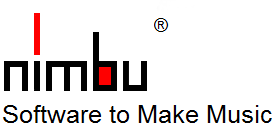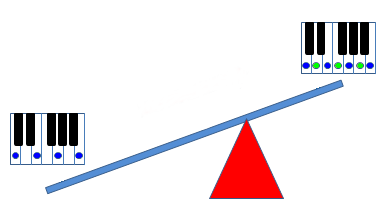Basic Settings
With nimbu you transpose the accompaniment in real time with the chords you are playing with your left hand.
Whatever you play, nimbu always translates your chords into chord scales. This means you always play with a supply of at least seven 7 tones. With one of these three basic settings:
The clou is that you can switch spontaneously while playing. You can switch in real time e.g. from title-related to chord-related playing in order to play every harmony freely.
nimbu is an auto accompaniment system that shows you how music really works.
Whatever you play, nimbu always translates your chords into chord scales. This means you always play with a supply of at least seven 7 tones. With one of these three basic settings:
-
Chord related playing (auto accompaniment)
Here the tension tones are converted into chord tones. The tones of the accompaniment are reduced to the chord tones. So you play like with any automatic accompaniment.
Scale related playing (improvisation)
Chord notes as well as tension notes are played here in order to use all available tones. This is the mode for improvisation. Standard scales are assigned to the played chord types. If a standard scale does not fit, you assign the correct scale to the chord.
Title-related playing (title)
This, too, is a scale-related playing used for the original accompaniments, which nimbu automatically calculates from MIDI files. Tones that are out of scale are also allowed in order to get as close as possible to the original.
The clou is that you can switch spontaneously while playing. You can switch in real time e.g. from title-related to chord-related playing in order to play every harmony freely.
nimbu is an auto accompaniment system that shows you how music really works.
The Way Music Works
Western music moves in keys. If you play a chord to a song, the tones of your chord are part of a key. Therefore, at least melodically, all 7 tones of this key can always be played to this chord. This applies to every chord and every degree of the key. And it applies to the melody as well as the accompaniment. To get all available tones of the key for playing, you only have to add the remaining tones of the key to the tones of the chord you are playing.
This is exactly the case with the chord scale. The chord scale of a chord simply adds the remaining tones of the key, so-called tension tones or tensions, to the tones of the chord. That is all. While the tones of the chord are struck simultaneously, the chord scale specifies the 7 tones that can be played to this chord. In this way, chords and their chord scales form a functional unit via the key.
We practically demonstrate the relationship between chord and chord scale in our video E Video 5 "More tones for the auto accompaniment". This relationship is so simple and yet so fundamental. This is our basis for giving your accompaniment all available tones without knowing the key.
In nimbu you play the way music works. Your accompaniment is neither reduced to chord tones, nor does its larger tone supply result from some sort of playback in which so-called transpositions use only the root or only the root and third of the chords you play and play the rest to you. There are no so-called Session Styles, which play their own chords even in the Main sections.
All this has nothing to do with jazz, by the way. The chord scales are the basis for improvising and song writing. But that is a much higher level. Here it's all about giving your backing band the musically available tones. In jazz, on the other hand, the scales are used extensively, making full use of the characteristic sound of the scales, whereby at times you are relatively far away from the actual harmony. But even this is possible in nimbu.
When improvising, the scales are often derived from chords (given by a song, so-called changes) and their chord degrees in order to impovise with the additional notes of these scales or to play new melodies.
This is exactly the case with the chord scale. The chord scale of a chord simply adds the remaining tones of the key, so-called tension tones or tensions, to the tones of the chord. That is all. While the tones of the chord are struck simultaneously, the chord scale specifies the 7 tones that can be played to this chord. In this way, chords and their chord scales form a functional unit via the key.
-
Tones of the Key = Available Tones = Tone Supply = Chord Scale = Chord Tones + Tension Tones
We practically demonstrate the relationship between chord and chord scale in our video E Video 5 "More tones for the auto accompaniment". This relationship is so simple and yet so fundamental. This is our basis for giving your accompaniment all available tones without knowing the key.
In nimbu you play the way music works. Your accompaniment is neither reduced to chord tones, nor does its larger tone supply result from some sort of playback in which so-called transpositions use only the root or only the root and third of the chords you play and play the rest to you. There are no so-called Session Styles, which play their own chords even in the Main sections.
All this has nothing to do with jazz, by the way. The chord scales are the basis for improvising and song writing. But that is a much higher level. Here it's all about giving your backing band the musically available tones. In jazz, on the other hand, the scales are used extensively, making full use of the characteristic sound of the scales, whereby at times you are relatively far away from the actual harmony. But even this is possible in nimbu.
When improvising, the scales are often derived from chords (given by a song, so-called changes) and their chord degrees in order to impovise with the additional notes of these scales or to play new melodies.
| Chord Progression >> | assigend Chord Scales >> | available Tones for Improvisation |
| Harmony | Melody |
| Ideas for tone progression <> | Key >> | Chord Progression |
| Melody | Harmony |
MIDI File

The Standard MIDI File Specification (SMF) defines how music is stored digitally with its notes and a wealth of other information, without having to include the instrument sounds. This specification of the MIDI Association is an open, manufacturer-independent, globally recognized industry standard.
nimbu embraces the fact that nowadays MIDI files are offered on the internet for almost every song mostly free. Midi and the title of the song are sufficient search terms. As a source for professional MIDI files we can also recommend geerdes Media e.K. in Berlin, whose MIDI files are very close to the original and cost only a few Euros.
nimbu embraces the fact that nowadays MIDI files are offered on the internet for almost every song mostly free. Midi and the title of the song are sufficient search terms. As a source for professional MIDI files we can also recommend geerdes Media e.K. in Berlin, whose MIDI files are very close to the original and cost only a few Euros.


